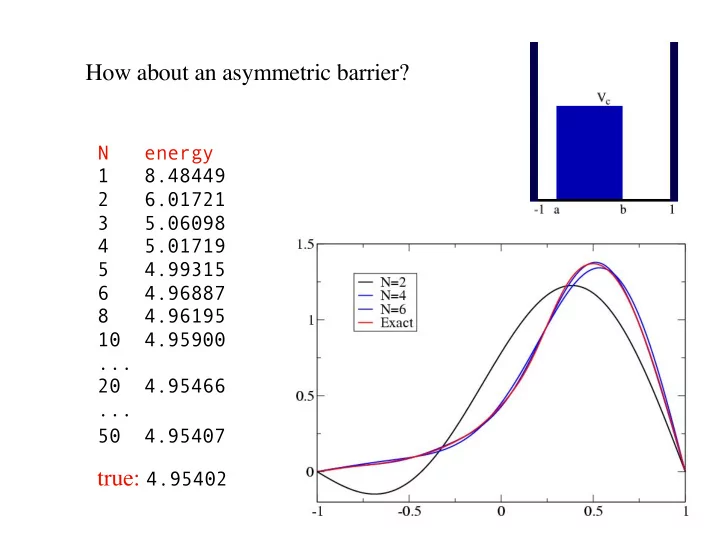

How about an asymmetric barrier? N energy 1 8.48449 2 6.01721 3 5.06098 4 5.01719 5 4.99315 6 4.96887 8 4.96195 10 4.95900 ... 20 4.95466 ... 50 4.95407 true: 4.95402
Let ’ s do a large barrier; V c =50 What ’ s going on? Ø No agreement N energy 2 29.93480 Ø Wrong symmetry? 4 14.86237 (comp with Numerov) 6 13.79536 8 13.62645 10 13.56317 ... 20 13.48853 30 13.47853 ... 100 13.47439 Numerov: 13.45011 (based on 10 8 steps)
Explanation Two almost degenerate states (symmetric/anti-symmetric) Ø Numerical accuracy problems; Numerov mixes them Ø The variational method easily keeps them separated (but larger errors in the energy) N=20 E0=13.4885 E1=13.4904 N=100 E0=13.4744 E1=13.4773 Numerov: 13.45011 (based on 10 8 steps)
The Schrodinger equation in discretized real space Example of grid-based method for 2D and 3D problems Basis of states localized in small volume element Ø large number of such states neded in 2D and 3D Ø the resulting N*N matrix is too big to be fully diagonalized Ø special methods exist for lowest states of sparse matrices - N up to several million (even 10s or 100s of millions) Cubic d-dimensional space elements; Label by coordinate or number Coordinate of element Non-overlapping (orthonormal basis)
Strictly speaking, these are not valid wave functions (discontinuous) However, we will obtain a scheme that gives the correct physics in the limit (we could also in principle use some continuous localized functions) Size of the basis in a box with side L: Matrix elements of Hamiltonian The potential energy is diagonal Kinetic energy − How do we deal with the non-differentiability?
Using central difference operator in place of derivatives Ø Can we do this when the functions are not smooth? Ø We will show that it in fact produces correct results Work in one dimension for simplicity - Can be directly generalized to higher dimensionality Replace second derivatives of the basis functions by Produces non-zero values in the neighboring elements
The kinetic energy matrix elements are − This means that when K acts on a state Non-zero matrix elements of the full Hamiltonian Generalizes to 2D and 3D; kinetic energy “ hops ” localized particle between nearest-neighbor volume elements denotes a neighbor of j (2,4,6 neighbors in 1D, 2D, 3D)
Proof of correct continuum limit for free particle in a box 1D for simplicity (generalizes easily) Periodic box of length L; energy eigenstates Energy: Discretized space, N cells; we will prove that the eigenstates are limits momentum; Discrete coordinate so only N different momenta
Acting with kinetic energy on proposed state: Shifting the indexes in the j +/- 1 terms by +/- 1 Energy eigenvalues are Taylor expand for small Agrees with continuum result to leading order, i.e., the way we treated the kinetic energy in the discretized space was ok. Note that the discretized energy is lower than the true energy 3D:
Recommend
More recommend